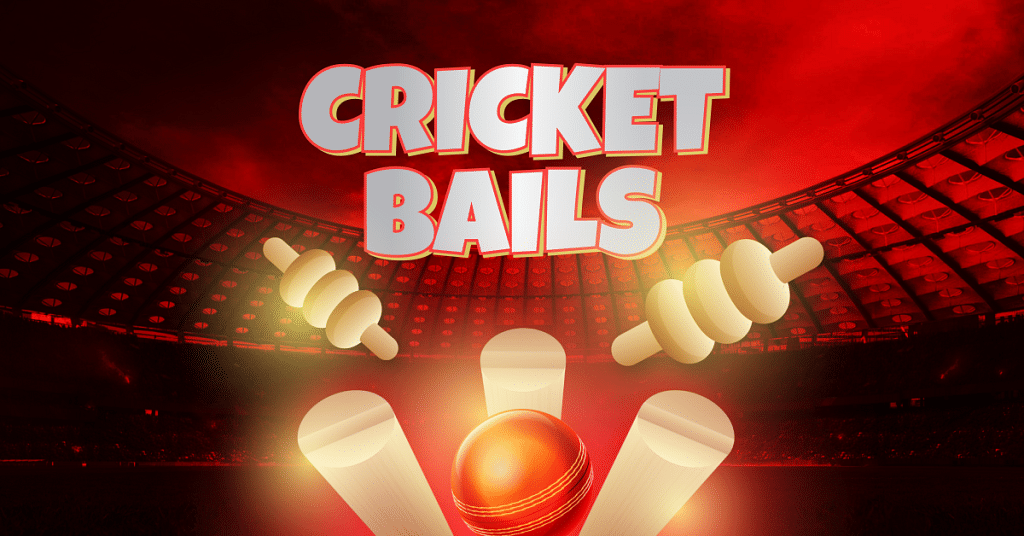Bails in Cricket have become an integral part of the game. Their appearance and the role they play within the game are quite specific. But what exactly are bails in cricket, and why are they so important?
In this article, we’ll look at the role of Bails in Cricket and how understanding this concept can help you gain a deeper appreciation for the sport. We’ll also discuss some of the most common scenarios where Bails can impact the game. So, let’s get started and learn more about bails in Cricket!
What are Bails in Cricket?
Bails in Cricket are small wood pieces that sit atop the stumps at each end of the wicket and are used to determine whether a batter is out or not. The batsman is out if the ball strikes the stumps and dislodges the bails. It is also applicable for stumpings, run-outs and hit-the-wicket.
Bails indicate the end of a session in Test cricket, as the umpire will remove them when the session is over. Without bails, Cricket would be much more difficult to control and would be an entirely different game.
How do Cricket Bails look?
These are two smaller tubular pieces that protrude from the two edges of a central cylindrical component. The side parts of the Bails are called ‘Spigots’, while the inner side is called a ‘Barrel.’
What are the Dimensions of Bails in Cricket?
The dimensions and sizes of the bails are fixed, but there is no specification regarding weight. The bails should be heavy enough so they won’t fall due to a gentle breeze, but they should also not be so heavy that they never knock off.
- Overall length- 45.16 in (0.95cm)
- Barrel Length- l – 2.13 inches (5.40 cm)
- Shorter spigot length- 0.81 inches (2.06 cm)
- Longer spigot length – 1.38 inches (3.50 cm)
Why is it important?
Bails may seem very small, but their importance in the game cannot be underestimated. The appearance and role they play within the game are quite specific.
- They determine when the batsman gets runs out, hit-wicket, stumped out or bowled.
- Depending on the situation, it can determine a no-ball, out, or not out.
Cricket Bails: What are they made of?
A bail is traditionally made from wood and can either be left natural or colored for limited competition. Heavy bails are made of lignum vitae, a denser kind of wood. This is used to prevent the bails from falling off the stumps by themselves in windy conditions.
Bails have evolved along with the game of Cricket. In recent years, plastic bails called Zing Bails, or Smart Bails, have been developed to light up when dislodged from stumps. Smart bails are designed with Led Technology.
How do Bails in cricket work?
CBails determine whether a batter is out, runs out, or hit a wicket or stumps.
The batsman is considered out when the ball hits the stumps and is dislodged. The batsman is not out if the ball hits the bails without dislodging them.
The bails are also used to decide whether a delivery is a no-ball or a wide. It is a no-ball if the bails are knocked off before the ball reaches the batsman.
Smart bails help address visibility issues arising on close calls on taking wickets, especially in day-night matches. It also makes it easier for umpires to decide by lighting up when the ball touches the wicket.
Final Thoughts
The Bails in Cricket are an essential part of the game, as they can help determine whether the batter is out or not, and umpires make accurate decisions.
Stay tuned to Fun88 Blog website for more updates and information on the Bails in Cricket.
People also ask about Bails in Cricket:
1. Is Cricket better because of technology?
Today, technology plays a crucial role in the sport, helping umpires make better decisions. This allows every minute detail of the match to be captured and monitored, thereby making the match fair.
2. In a wicket, how many bails are there?
In each set, three wooden stumps are topped with two wooden bails.
3. If the bails remain in place, does it count as out?
It will be counted as out if the bails fell off and dislodged from the stumps after the ball hit them, but not if the bails did not fall off.
Related Read: Dot Ball in Cricket Explained | Importance, Stats & Rules
Star it if you find it helpful.

